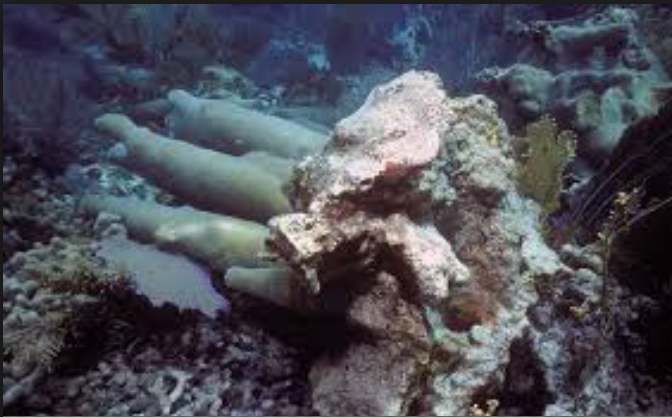KNOCKED OVER, BUT NOT OUT? Coral reef communities at St. John, U.S. Virgin Islands, pictured here years before the recent hurricanes struck. (Credit: Howard Lasker)
[ad name=”HTML-68″]CRUZ BAY — A New York geologist will journey to St. John this month to study the impact of hurricanes Irma and Maria on coral reefs in the region.
Howard Lasker will spend two weeks aboard a research vessel docked in waters of the Virgin Islands National Park.
“We won’t know the extent of damage on the reefs until we are able to get into the water,” Lasker said. “Hurricanes create huge waves in the ocean, and these go crashing onto the reefs with great force. Sand also gets tossed around, so it’s like sandblasting. These direct physical impacts can cause a lot of harm.”
Lasker, who departs for St. John on Nov. 18 aboard the F.G. Walton Smith, the University of Miami (UM) Rosenstiel School of Marine and Atmospheric Science’s research vessel.
With his collaborator, Peter Edmunds, from California State University, Northridge, Lasker has been researching reefs off St. John’s southern coast for years.
The team has been documenting which coral species live there today, and examining photographs dating back to 1987 to determine how the composition of reefs has changed.
The focus is on understanding the balance between hard, stony corals, which form the backbone of ocean reefs, and softer, more flexible gorgonian corals — tree-like species that form an underwater forest of sorts, providing habitat for small fish and other aquatic life.
The hurricanes add an unexpected variable to this work.
“It’s interesting because it’s a natural experiment,” Lasker says. “It’s not an experiment that you could in good conscience conduct yourself, but we can learn a lot from studying the recovery if there has been any damage.”
Coral reefs act as habitats for fish and other wildlife, providing food for communities worldwide and generating tourism dollars for seaside economies. Investigating how traumatic events like hurricanes affect these important resources is particularly vital in a time of global climate change, Lasker says.
Relief efforts will be part of the mission
The recent, back-to-back hurricanes devastated St. John, which is part of the U.S. Virgin Islands. The storms destroyed many structures, leaving residents homeless and communities without electricity for weeks. The Virgin Islands Environmental Resource Station — Lasker’s usual home base on St. John — is no longer operational, he says.
As part of the research trip, he and Edmunds, along with the UM Rosenstiel School Marine Operations staff, are coordinating to bring supplies to the island aboard the F.G. Walton Smith.
This planned relief effort will support the Love for Love City Foundation.
The charity, started by country music singer Kenny Chesney, who has a home on St. John, has delivered food, water, medicine, flashlights, generators and more to the Virgin Islands in the weeks since the hurricanes.
For coral reefs, hurricanes are like wildfires
Lasker’s trip to St. John is funded by a $126,000 grant from the National Science Foundation, which is also paying for his time aboard the F.G. Walton Smith.
His team will include Angela Martinez Quintana, a UB PhD student in Lasker’s lab; Jacqueline Krawiecki, a recent UB master’s graduate from the lab; and Douglas Penninger from the Georgia Aquarium. They will be based aboard the F.G. Walton Smith and take smaller boats out to dive sites along St. John’s southern coast.
Lasker is unsure what they will find, but in general, he compares the effect of storms on coral reefs to the effect of wildfires on forests.
“Hurricanes have always occurred,” he says. “They can cause extensive damage, but then the populations start to recover. It’s analogous to forest fires: After a number of years, the forest starts returning. There’s a period of disturbance, and then the system recovers.”
But scientists still have a lot of questions about how coral reefs bounce back.
For example, few researchers have looked in detail at the plight of soft corals — Lasker’s area of expertise. There are some clues that these species may fare better than their stony counterparts after a disaster, but more research needs to be done to understand how storms, warming waters and ocean acidification can alter the composition of reefs, and whether these changes are permanent or short-lived, Lasker says.





